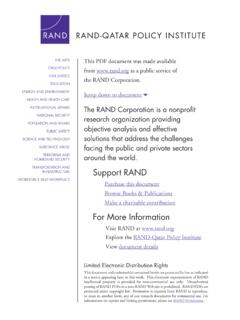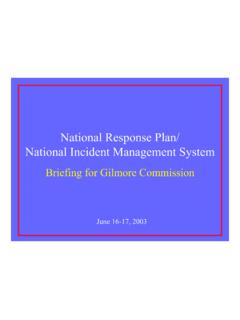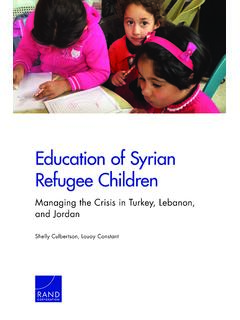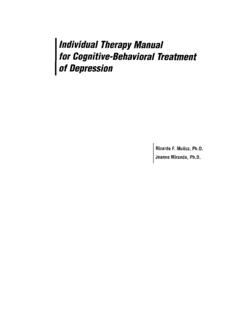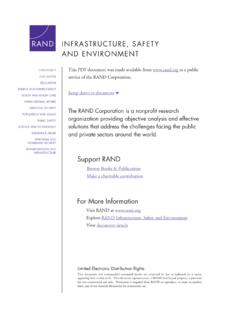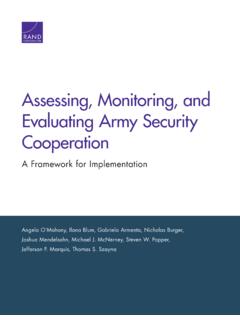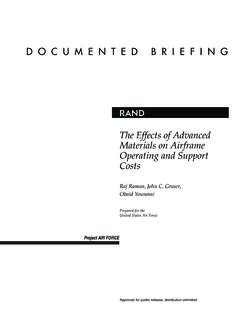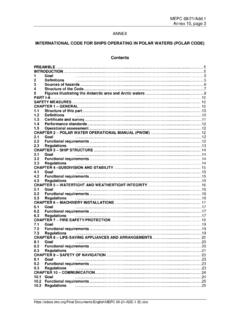Transcription of Air Force Commander's Guide to Diversity and Inclusion
1 Air Force Commander's Guide to Diversity and Inclusion Nelson Lim C O R P O R AT I O N. To perform, we need top talent. Today we claim the title World's Greatest Air Force ,'. but to remain so, we must learn to be comprehensively inclusive, throughout our ranks, and throughout our specialties. If we get this right, we will glean significant benefit from the many perspectives of the population we serve. Air Force Secretary Deborah Lee James I N T R O D U C T I O N A N D P U R P O S E. M. odern military operations are executed in complex, uncertain, and rapidly changing operational environments that defy the warfighting standards of the past.
2 To meet these challenges, the Air Force must employ every advantage. Diversity is an advantage, and the Air Force has expanded its approach to Diversity from one that focuses on race, ethnicity, and gen- der to one that includes skills, background, and ways of thinking. This transition will require an adaptive and agile leadership that can leverage Diversity while maintaining unit cohesion. The military is both influenced by and has an influence on civilian society. The mil- itary is generally regarded as a model for racial integration. When President Harry Truman issued Executive Order 9981 (1948) to end racial segregation in the military, the military became a catalyst for change.
3 Nearly 70 years later, the military continues to lead and learn when it comes to Diversity . In that spirit, this is a brief introduction to Diversity and Inclusion for today's busy com- manders. How Does the Department of Defense Define Diversity ? D oD's Diversity and Inclusion Strategic Plan (2012). defines Diversity this way: All the different characteristics and attributes of the DoD's Total Force , which are consistent with our core values, integral to overall readiness and mission accomplishment, and reflective of the nation we serve. The definition acknowledges that individuals come to the military not only with different cultural backgrounds but also with different skills, experi- ences, and talents.
4 It also acknowledges that these differences are operationally relevant. With proper leadership, Diversity can increase military agility and responsiveness. 1. How Does the Air Force Define Diversity ? A ir Force Instruction 36-7001 (AFI, 2012) defines Diversity as: A composite of individual characteristics, experiences, and abilities consistent with the Air Force Core Values and the Air Force Mission. Air Force Diversity includes but is not limited to: personal life experiences, geographic back- ground, socioeconomic background, cultural knowledge, educational background, work back- ground, language abilities, physical abilities, philosophical/spiritual perspectives, age, race, ethnicity, and gender.
5 2. What Diversity Encompasses According to the AFI, Diversity encompasses: demographic Diversity : inherent or socially defined personal characteristics, including age, race/. ethnicity, religion, gender, socioeconomic status, family status, disability, and geographic origin cognitive/behavioral Diversity : differences in styles of work, thinking, learning, and personality organizational/ structural Diversity : organizational/. institutional background characteristics affecting interaction, including service, component, and occupation/career field global Diversity : intimate knowledge of and experience with foreign languages and cultures, inclusive of both citizen and noncitizen personnel, exchange officers, coalition partners, and foreign nationals with whom we interact as part of a globally engaged Air Force .
6 3. Gay and Lesbian Service Members In June 2015, Secretary of Defense Ashton Carter announced that gay and lesbian service members will be afforded the same protection under the military's equal opportunity policy as other groups. 4. Does Such a Broad Definition Hurt Minorities? S ome critics believe that to define Diversity in a way that goes beyond race/ethnicity and gender is to define away the very real challenges that specific groups still face. While this concern is understand- able, interpreting Diversity more broadly can still help increase women and minorities in military leadership, given that no one group has a monopoly on the diverse skills and talents that military leadership requires.
7 In addition, the broad definition reflects the reali- ties faced by today's military. Just as a more diverse population affects the demographic mix of Air Force recruits, changes in budgetary and conflict environments affect the need for new skills, more integration across military components, better coordination with other government agencies, and smoother cooperation with global partners. 5. Progressing from the equal opportunity model of Diversity used in the past to the broader concept of Inclusion for the future is consistent with equal opportunity policies and practices because it is based on the fair and equitable treatment of all personnel, regardless of their membership in a protected class.
8 6. Is Inclusion the Same as Equal Opportunity and Affirmative Action? N o. Affirmative action is a policy that favors those who tend to suffer from discrimination, especially in employment or education. Equal opportunity is the policy of not discriminating against people on the basis of their sex, race, or age an obligation that the Air Force continues to take very seriously to ensure fairness and a level playing field for all airmen. Both policies are aimed in part at increasing an organization's demographic Diversity , generally through the assimilation of protected groups.
9 Members of the minority group adopt the language, customs, and atti- tudes of the majority group, and gravitate toward the norm. In contrast, Inclusion aims to preserve an indi- vidual's attributes and integrate them into the way an organization functions and makes decisions. In fact, equal opportunity is the foundation for Inclusion and Diversity . The concept of Diversity and Inclusion combines the best ideals of representation 7. with the practice of casting a wide net to recruit, train, foster, and promote people with any and all attri- butes that can benefit the services, including think- ing style, occupational background, and skill sets.
10 In other words, Diversity comprises characteristics and attributes that are both included and not included in equal opportunity law. 8. Though similar in concept, equal opportunity and Inclusion differ in several ways. Historical: In the 20th century, the central issue was representation of protected groups in military and civilian workplaces. In the 21st century, Inclusion becomes part of the equation. Diversity driver: The representation of protected groups has been driven by external concerns: equal opportunity laws and societal factors. But Inclusion is driven by internal concerns: Diversity leadership and mission effectiveness.

